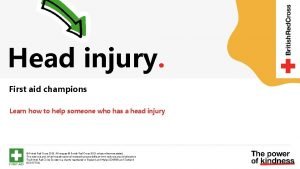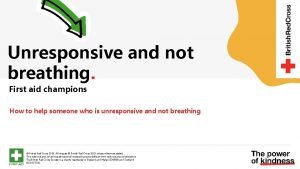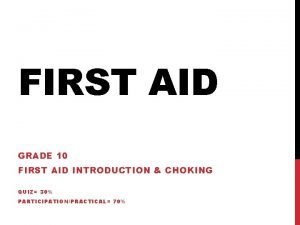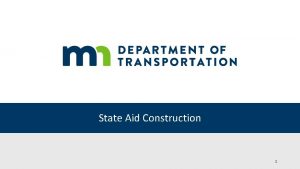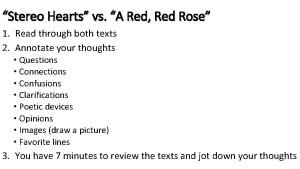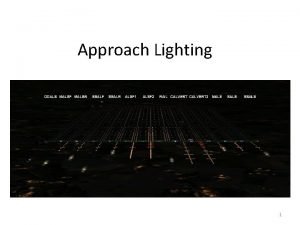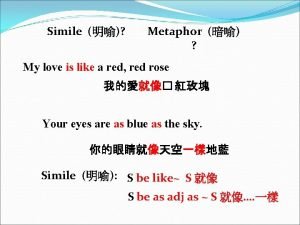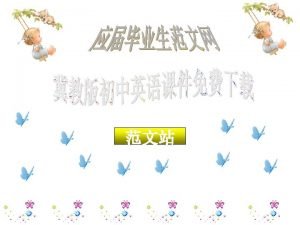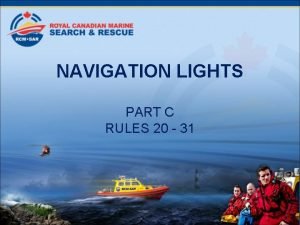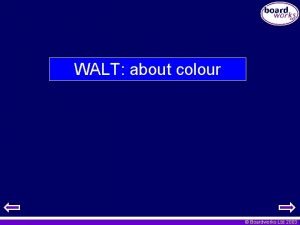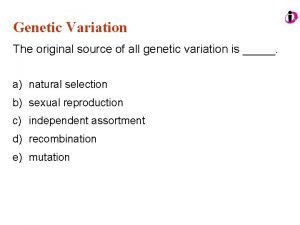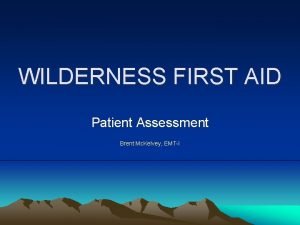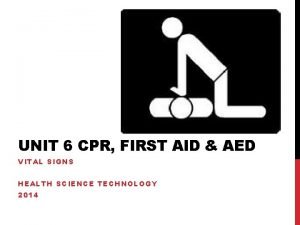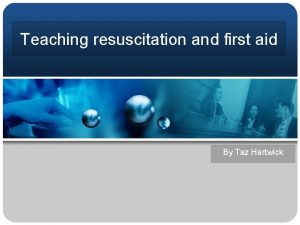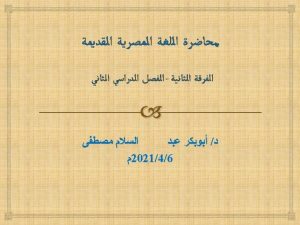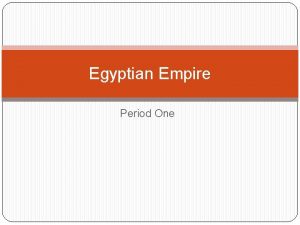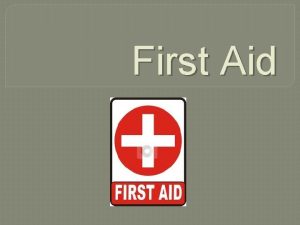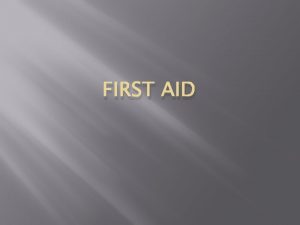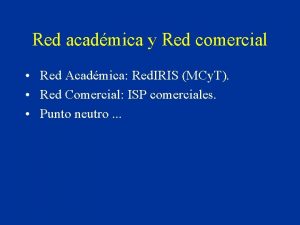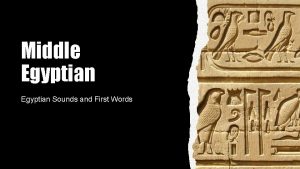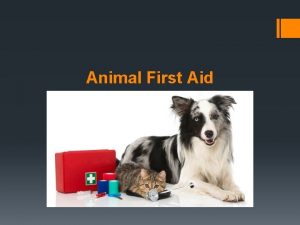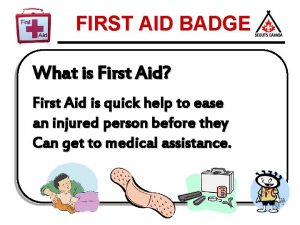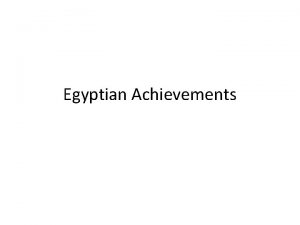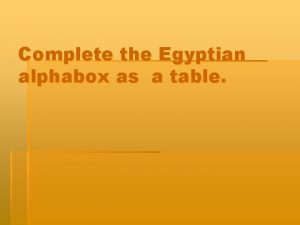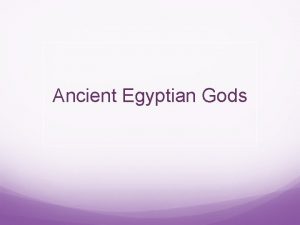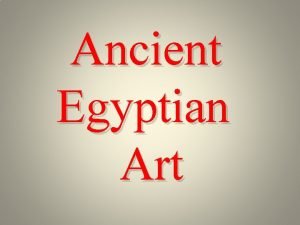First Aid DK First Aid Manual Egyptian red
























- Slides: 24

First Aid §DK First Aid Manual §Egyptian red crescent §International Red Cross §St. John Ambulance §St. Andrew’s Ambulance Association §Virtual Naval Hospital

Agenda o o o o Red crescent and red cross history First aid person prerequisites Action at an emergency Resuscitation Practice of first aid Hysteria Treat shock Angina pectoris & heart attack Wound and bleeding Burns Body temperature Bones injuries Foreign bodies in the eye Dressing and bandages Emergency action

Red crescent and red cross history A Swiss businessman, Henry Dunant, founded the worldwide Red Cross Movement. As a traveler in 1859, he witnessed a one-day battle between Austrian and French forces outside the northern Italian town of Solferino. At nightfall and to his horror, he saw 40, 000 dead and wounded soldiers strewn about the battlefield who had lacked any medical attention. Dunant immediately set about organizing care for the wounded with the assistance of local villagers, And from this horrible view that the international Red Cross movement idea was founded. In Geneva October 1863 and by 16 countries the Red Cross agreement were signed. The Red crescent was first founded back at the Ottoman era at 1876 they decided to use the Red Crescent as a badge for the medical troops in the Balkan war

First aid person prerequisites o o Always remember that you are not a doctor you are only providing temporary support until professional medical assistance is available. The purposes of first aid are 1. 2. 3. o o o to save life, prevent further injury to minimize or prevent infection. Fast reflection and reaction. Fast changing in way of thinking. Very calm in the bad situation.

Action at an emergency 1. Safety - Determine if the area is safe. 2. Medical information devices - Examine the casualty for a MEDIC ALERT or info about medical conditions 3. Number of casualties - Look beyond the first casualty, you may find others. 4. Bystanders - Ask bystanders to help you find out what happened. 5. Introduce yourself - Inform the casualty and bystanders who you are and that you know first aid. 6. Call emergency ask a bystanders to call emergency number (in Egypt 123)

Resuscitation o Always start by analysis (ABC procedures)

Resuscitation o Use recovery position if necessary

Resuscitation o You better start early Cardio Pulmonary Resuscitation CPR and know where to push the chest how much and the ratio.

Resuscitation o o Pay strict attention Look and control all major bleeding Treat casualty by condition order Remember possibility of hidden secondary injury

Practice of first aid o o o Make a diagnosis Find clues about the medical history of the casualty and the condition Symptoms and signs Top to tow survey Remove clothing from the injured area Passing on information you gathered about the casualty

Hysteria o o o Do Not throw water on the Casualty’s face Do Not slap the casualty’s face Do Not use force to retain him If it leads to chock treat chock Escort the casualty to a calm place Stay calm with the casualty and try to calm him

Treat shock o o o Do not let the casualty move unnecessarily, eat, drink or smoke. Do not leave the casualty unattended. Treat cause of the chock Lay him down head low Insulate the casualty from cold (above and below) Record breathing, pulse and level of response

Angina pectoris & heart attack o o Make the casualty comfortably half sitting position Call for help (123 or the casualty doctor) ask for a Cardio Pulmonary Resuscitation ambulance If the casualty is conscious give him an aspirin to chew it slowly Be ready for a CPR

Wound and bleeding o o o Apply direct pressure on the wound Raise the bleeding over the heart level Remove any tide clothes Place a clean pad on the cut never change the pad put another one on it if necessary

Wound and bleeding o o o Never put a cloth with adrenalin in the nose Sit the casualty down with his head well forward Ask him to breath through his mouth Press on the nose for a period of 10 minutes Ask him to rest quietly for a few hours

Burns o o o o Do not remove anything sticking to the burn Do Not apply toothpaste, lotions or fat to the injury Lay casualty down Pour cold water on the burn (take care don’t take him into hypothermia) ABC procedures Cover the burn with clean tissue Treat for chock

Body temperature o Deep Hypothermia n n If tempreture lawer than 26 C. / 79 F Do Not place heat source beside the casualty this speed up blood flow through the skin causing “after drop” Well cover the casualty Give a conscious casualty hot drink and honey or chocolate

Body temperature o Extreme heat and heatstroke n n Move casualty to a shadow and cool place Remove outer clothing Wrap casualty in a cold wet sheet and keep it wet Make him drink salty solution (one teaspoon on a liter of water)

Bones injuries o o o Do Not move the casualty until he is secured and supported Do Not let the casualty have anything to eat or drink Never try to but the bone back into its place this might get a seconded injury If the bone comes out treat bleeding first Keep him still Support and secure the insured part

Foreign bodies in the eye o o o Do not touch anything sticking in the eye Advice the casualty not to rub his eyes If you can see the body wash it out with pure water If this was unsuccessful and the foreign body is not stuck lift it off with a moist swap When moving casualty cover injured eye with a pad and cover both eyes with a bandage

Dressing and bandages

Dressing and bandages

Emergency action o o o o Make the area safe Get help Fire (fumes, opening doors, never get into the fire) Earth quake (duck, cover and hold, evacuate building, out the street) Car accident (more accident, falling things, explosions and fire, moving the casualty, taking off the helmet) Electric shocks (law and high voltage) Rescue from drowning (use something, never come from the front) Multiple casualties (clear minor, jump over dead, treat breathing problem first shock seconded bleeding third broken bones fourth)

Stay in touch http: //groups. yahoo. com/group/First_aid_Egypt/ Ayman F. Saleh
 First aid merit badge first aid kit
First aid merit badge first aid kit Floral design history
Floral design history Red cross first aid champions
Red cross first aid champions First aid champions red cross
First aid champions red cross What are the objectives of first aid?
What are the objectives of first aid? State aid manual
State aid manual State aid manual
State aid manual Neasden and greenhill medical centre
Neasden and greenhill medical centre Exaggeration in stereo hearts
Exaggeration in stereo hearts Ssalr lighting
Ssalr lighting A red, red rose figures of speech
A red, red rose figures of speech Simile for red
Simile for red What color
What color White over red pilot ahead
White over red pilot ahead Poetic devices table
Poetic devices table Why does a red ball look red
Why does a red ball look red Red-orange-yellow-green-blue-indigo-violet
Red-orange-yellow-green-blue-indigo-violet Song red and yellow blue and green
Song red and yellow blue and green The original source of all genetic variation is
The original source of all genetic variation is First aid patient assessment
First aid patient assessment Air cadets badge placement
Air cadets badge placement Hypertension vs hypotension
Hypertension vs hypotension Unit 15:6 providing first aid for burns
Unit 15:6 providing first aid for burns Coyne first aid
Coyne first aid Chample first aid
Chample first aid


